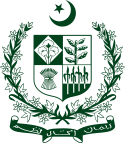The union councils of Pakistan (Urdu: یونین کونسل), referred to as village councils in villages, are elected local government bodies consisting of 21 councillors, and headed by a Nazim, which is equivalent to a mayor or chairperson, plus a Naib Nazim (vice chairperson). As of 2007, there are 5,375 rural union councils across 115 districts. They form the third-tier of local government and fifth tier overall. Its structure and responsibilities differ between provinces and territories.
Administration
Union councils are the primary governmental institution in Pakistan. They are often known as "village councils" in rural areas. The territory represented by a village council usually comprises a large village and surrounding areas, often including nearby small villages. The term "union council" may be used for localities that are part of cities. The territory of a union council or village council is usually part of a tehsil (township). Less commonly, a union council may be part of a city district.
Headed by a Union Nazim, each union council has 13 elected members or councillors. In addition to four male and two female members elected directly, there are two male and two female representatives of the labour, a minority member, a Union Nazim, and his deputy, known as Union Naib Nazim. Besides elected members, there are several government employees and functionaries in every union council, who report to the secretary of the union council. The latter is a civil servant appointed by the state. The addition of seats for minority members and special interests was implemented in part due to people not wanting to run for election when the union council system was first implemented.
Union councils perform numerous functions including levying taxes, building infrastructure, and acting as an alternative dispute resolution system.
References
- Baqir, F. (2007). UN Reforms and Civil Society Engagement. UNRCO, Islamabad. https://citeseerx.ist.psu.edu/viewdoc/download?doi=10.1.1.539.3258&rep=rep1&type=pdf
- Introduction to Union Administration - City Government of Lahore
- ^ Ziring, Lawrence (1965). "The Administration of Basic Democracies: The Working of Democracy in a Muslim State". Islamic Studies. 4 (4): 393–440. ISSN 0578-8072. JSTOR 20832817.
- Hussain, Syed Shahbaz; Sabri, Pirzada Sami Ullah (1 January 2014). "National Environmental Policy Development for Sustainable Economic Growth in Developing Countries: A Case Study of Pakistan". International Journal of Social Quality. 4 (1). doi:10.3167/IJSQ.2014.040106. ISSN 1757-0344.
- Khan, Muhammad (2020). "Justice Delayed is Justice Denied: Access to Speedy Justice and Alternative Dispute Resolution System in Pakistan" (PDF). Journal of Law and Social Policy. 2.


